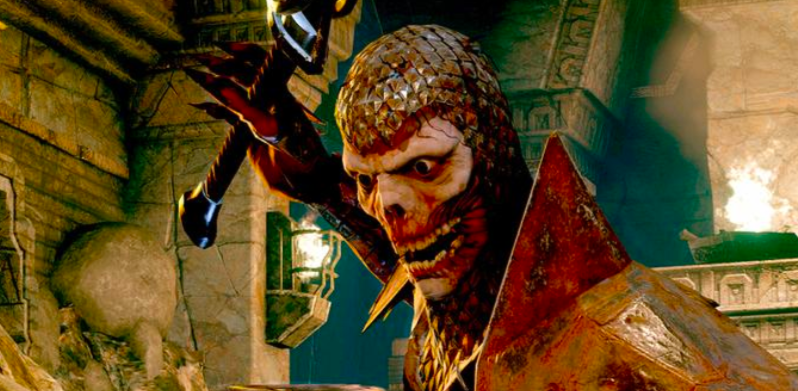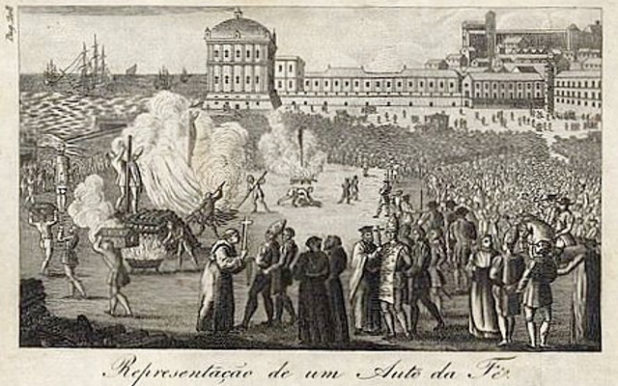Diversity Macht Frei
December 7, 2018
Jews have got themselves another Holocaust day, another day on which the Unchosen must bow down to them and beg their forgiveness. This time it’s in Portugal.
A Portugal government committee has approved the creation of a Memorial Day for the Victims of the Inquisition.
The inquisition was formally established in Portugal in 1536. The date of the memorial day will be held on or around March 31, the official end of the Inquisition in 1821.
Reconectar, the movement to reconnect the descendants of Spanish and Portuguese Jewish Communities with the Jewish world, welcomed the decision by the Commission for Culture, Communication, Youth and Sports of the Portuguese Parliament.
“This is an extremely important step by the Portuguese Parliament and one that clearly demonstrates the Portuguese authorities’ intention to look critically at its past and show the Jewish world that it is seeking atonement for this reign of terror against our people,” Ashley Perry, president of Reconectar and the director of the Knesset Caucus for the Reconnection with the Descendants of Spanish and Portuguese Jewish Communities, said in a statement issued on Wednesday.
Reconectar is assisting in the reconnection of the tens of millions of people in North and Latin America, Europe and elsewhere, who are discovering their Jewish ancestry. Modern technology, Internet, and genealogy and DNA advances have generated interest in discovering hidden Jewish roots.
Nearly 1,800 descendants of Sephardic Jews acquired Portuguese nationality in 2017 under a law enacted two years earlier, with another 12,000 still in the application process.
The tally for 2017 is six times higher than the total for 2016, during which the application of the law hit bureaucratic snags amid political changes.
The increase in naturalization under the law, which Portugal passed in 2013 and enacted in 2015 as a form of making amends for the persecution of Jews during the Inquisition, comes amid a host of initiatives by the government to strengthen the country’s ties to Jewish audiences and recognition of its Jewish heritage.
I’ve made the point before but it needs reiterating because the Jews keep lying about it: THE INQUISITION HAD NO POWER OVER JEWS. Its powers applied only to professing Christians. So when modern Jews claim their ancestors suffered under the Inquisition, they are implicitly admitting that these Jews were not real Christians, but only pretending to be. In other words, THEY ARE ADMITTING THAT THE INQUISITION WAS RIGHT when it punished them for being fake Christians. Either that, or they are using a definition of Jewishness based purely on genes and not faith.
Portugal was not separate from Spain at the time the Muslims invaded in the 8th century, so they suffered just as the Spanish did. The Jews facilitated this Muslim invasion of Iberia. Therefore the Portuguese owe them no “atonement”. It’s the other way around. It’s time the Jews started atoning for the harm they have inflicted on the various peoples they have lived among.
The reality is that the Portuguese Inquisition performed a an extraordinary humanitarian service for which you would think the modern left would want to thank it, namely inhibiting the slave trade. Many of the top slave traders, both in Portugal and its overseas colonies, were fake-convert Jews. When they eventually fell victim to the Inquisition, the slaves they had traded came and enjoyed watching them burn.
Here’s an extract from Hugh Thomas’ book “The Slave Trade”.
But the Inquisition was still concerning itself with the alleged Judaizing activities of all Portuguese merchants, whether or no they were involved in the slave traffic. The traders of Seville were thereby enabled to have their revenge on the traders in Lisbon, whose economic dominance they had so long resented. Thus 1636 saw the trial of Francisco Rodrigues de Solis of Lisbon, brother-in-law of the monopolist of the 1620s, Antônio Fernandes Elvas. Sent to Cartagena de Indias to liquidate his affairs there, he fell into the hands of the Inquisition and was accordingly submitted to an auto-da-fé. There was in 1638 a big auto-da-fé in Cartagena, of João Rodrigues Mesa of Extremós, Portugal, who had sold a great number of Angolans since he arrived in the city in 1630. A large crowd of slaves, free blacks, mulattos, and some Spaniards threw oranges at him and other condemned men before they were burned.
Subsequent autos-da-fé would ruin the Portuguese slave-selling network in the New World. For example, in 1646 Antonio Váez de Acevedo, buyer and provider of slaves at Veracruz, and in 1649 his brothers, Simón and Sebastián Váez Sevilla, were humiliated (though not burned), in the terrible auto-general of that year. Sons of a butcher from Castellobranco, in north-east Portugal, who had acted as executioner and then become a stevedore in the port of Lisbon, Antonio had provided most of the African slaves who were sold in Mexico; Sebastián had been Purveyor-General to the recently founded Spanish Caribbean naval squadron, the Armada de Barlovento; and Simón had become one of the richest men in Mexico thanks to his slave dealings. Friend and protégé of the Viceroy, the Marquis of Villena, as well as holder of several governmental positions, on excellent terms at one time with bureaucrats of the very Inquisition which condemned him, Simón Váez had also prospered from the trade with China, via Acapulco. He had married Lorena de Esquivel, an old Christian – but philo-Semitic, according to the Holy Office, for had she not, years before, broken a pot in anger when a ham was cooked in it? In consequence of such minor matters were great fortunes lost. No doubt, Simón Váez and his brother Sebastián were secret Jews: as early as 1625, one of Simón’s accountants, Hernando Polanco, had denounced him for never permitting cooking with lard, and for arranging that his wife always arrived too late for mass. On the other hand, hostility towards the Portuguese merchants, Jewish or non-Jewish, was evidently a strong motive in the persecution in Mexico which was pressed ferociously by the temporary Viceroy, the brilliant and unbending Bishop of Puebla, Juan Palafox.
Simón Váez, betrayed by people who had worked for him, communicated during his seven years in prison with his friends and relations through some of the slaves whom he had sold so well; but to little avail. The auto-da-fé of 1649 was watched by it was said 30,000 people of every rank of society: how agreeable it must have been for the Indians and the African slaves to observe the parading of the great merchant, with his wife, his brother, and other relations, men and women, half naked and shaved, who, a few years before, had ‘driven through the city in coaches, receiving judges and their wives at their parties, respected as if they had been the grandest nobles of the kingdom’.
Similar trials of converso slave merchants were also held in Lima, above all that which, beginning in 1635, ended by incriminating the most important slave merchant there, Manuel Bautista Peres. Peres had been active in slaving since 1612, having been at first a captain of slave ships from Africa. He had been in Lima since 1620. In later years, he obtained slaves through his brother-in-law, Sebastián Duarte, who regularly bought Africans in Portobelo or Cartagena for shipment to Peru. Peres was looked upon as the leader of the Portuguese in Lima, and known there as ‘el capitán grande’. His fortune was estimated at 500,000 pesos, a large sum for that time. He owned silver mines in Huarochiri, fifty miles inland from Lima, where his house was so luxurious as to be nicknamed the de Pilatos. He conducted himself as a serious Christian, and priests educated his children; yet it was said that he held secret theological meetings which showed him to be Jewish. Peres never confessed to Judaism, and he tried unsuccessfully to kill himself with a dagger, but he and Duarte were both burned alive all the same.
The Inquisition of Cartagena de Indias had a similar bout of accusations. Thus Luis Gómez Barreto, also a converso, also a slave trader, who played an important part in the city between 1607 and 1652, was in the end seized and tried. His ceaseless travelling, in pursuit of the best slaves, between São Tomé and Luanda or between Guinea-Bissau and Benin, sometimes returning to Spain, and making four journeys at least to Lima, availed him nothing in the end. Then Manuel Álvarez Prieto, taught to be a practising Jew in Angola, was also tried for it in Cartagena de Indias.

